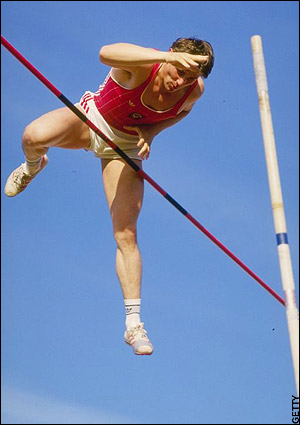Sergey Bubka: Are the Ukrainian Cosmonaut’s Records Safe?
(Opinion)
I’ve learned my lesson.
When Bob Beamon soared almost two feet beyond the existing long jump world record in mile-high Mexico City in 1968, I stood at the front of the line of those proclaiming Beamon’s incredible feat (29′ – 2.5″) as insurmountable.
I was proven wrong 23 years later when Mike Powell amazingly glided 29′ – 4.5″ at near sea level in Tokyo.
Powell’s record has now itself endured for 20 years.
So it is with a bit of fear and trembling that I now suggest Ukrainian Sergey Bubka’s world pole vault records may be among sport’s safest treasures.
Let me explain:
Bubka was simply in a class by himself
With no slight to Bubka’s rivals, the man was a supreme and fearless athlete who completely dominated the vault scene during his tenure. Even after his retirement in 2001, no one has come within nine centimeters (3.5″) of either his outdoor (6.14m / 20′ – 1.75″) or his indoor (6.15m / 20′ – 2.25″) records.
The closest threat to his indoor record has come from Australian Steven Hooker at 6.06m / 19′ – 10.5″. The closest active threat to his outdoor record has come from American record-holder Brad Walker at 6.04m / 19′ – 9.75″.
While 9 or 10 centimeters may seem minuscule at ground level, it becomes a huge mental barrier when negotiated upside-down at 20 feet in the air.
Indeed, since John Uelses first broke the 16-foot barrier in 1962, there have been 52 new outdoor records set, by an average increase of 2.4 centimeters. Considering that those 52 new records all came within the 32 years prior to Bubka’s mark (18 years ago), that 9 centimeter gap becomes a huge chasm.
In the exclusive “six-meter club” (19′-8.25″), consisting of 17 vaulters all-time, there have been 42 clearances by athletes other than the master. Bubka himself has breached that height on 45 occasions!
Standing on the runway, gazing at the crossbar, the spectre of Bubka’s incredible achievements must surely haunt any athlete daring enough to assault his records.
The proverbial *Asterisk Records
It is generally true that records were made to be broken. I say generally because some records will forever remain intact—if only unofficially—by reason of permanent changes to the particular event. Take for example the change in race distances formerly measured in yards, and now in meters. John Smith (UCLA, 1971) is still credited with the fastest 440-yard time (44.5) even though modern runners who now only race at 400-meters (437.4 yards), could probably beat that time.
Also consider the men’s javelin. Uwe Hohn, who threw a 700 gram implement in the early 1980s, is still regarded as the longest thrower in history (343′ – 1″). In 1986, the IAAF mandated a heavier 800 gram, more forward-weighted javelin and a whole new set of records had to be established.
My point being this: I think the men’s pole vault is approaching – or may have reached – the point of diminishing returns—much the same as the old rigid-pole era topped out near the 16-foot level. In those days of metal poles, the laws of physics and human strength had reached their limit.
The introduction of the flexible fiberglass pole so revolutionized the sport that, in my opinion, the old rigid-pole records deserve a spot in history solely unto themselves.
And the same may someday be true for Bubka’s records.
If it were simply a matter of athlete vs. world record (as in the case of Powell above), the question of any record being broken might be moot. But in pole vaulting, there is an implement involved – the pole.
Again, due to physical laws and strength limitations, modern poles have reached a maximum length of 17′ 6″ . On an attempt at a 20-foot vault, and considering the six-inch deep planting box, this means the athlete must perform an acrobatic handstand and jackknife over the bar at least three feet above the top of the pole.
Since no vaulter – except Bubka – has conquered that height in nearly twenty years of attempts, I am led to believe it may take another revolutionary equipment design to advance the sport beyond Bubka’s amazing standards.
So who has a chance?
Bubka himself has singled out only Hooker as a possible heir-apparent: “I am ready for the day. It is normal that there will be someone better than me.”
“Steve has already achieved the second-best result (apart from Bubka) in history. His results show he has good technique and the skills and ability to jump over six meters consistently”.
Hooker and Frenchman Renaud Lavillenie (6.01m) appear to be the only active vaulters with a ghost of a chance.
But still, that silly 9 or 10 centimeters tauntingly looms.
And one wonders if the crafty Bubka—who is known to have purposely elevated his own world records incrementally in order to maximize his bonus prizes—really believes his records can be broken.
After all, he and he alone, knows what it will take.
Quotes from The Australian, Feb. 2009


Great message, I actually look ahead to messages of your stuff.
Thank you, Jennell.
Are you a Bubka fan?
I was more than happy to discover your blog. I would like to thank you for publishing this excellent article! I’m absolutely enjoying every part of it and I have bookmarked the blog to come back for new stuff you post on your website.
As I have said before and still I am say now that your website has been the most awesome place for getting the updates related with sports. It’s a good thing that I am always here to have them.